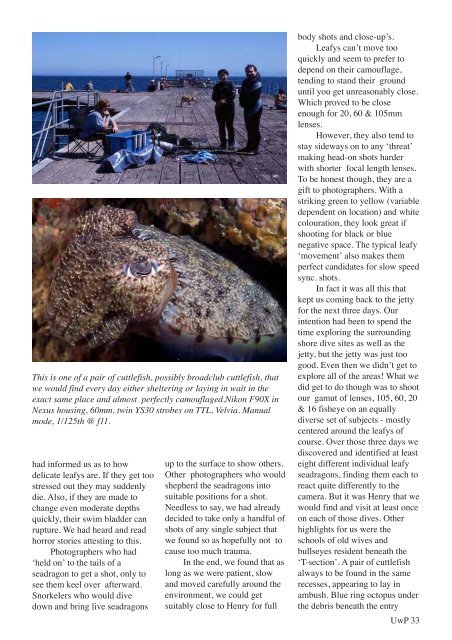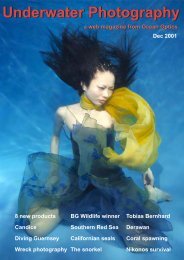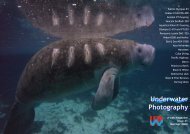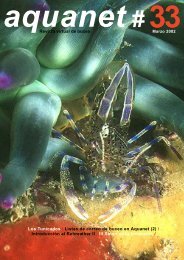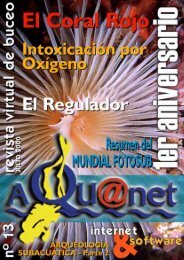Underwater Photography Underwater Photography
Underwater Photography Underwater Photography
Underwater Photography Underwater Photography
Create successful ePaper yourself
Turn your PDF publications into a flip-book with our unique Google optimized e-Paper software.
This is one of a pair of cuttlefish, possibly broadclub cuttlefish, that<br />
we would find every day either sheltering or laying in wait in the<br />
exact same place and almost perfectly camouflaged.Nikon F90X in<br />
Nexus housing, 60mm, twin YS30 strobes on TTL, Velvia. Manual<br />
mode, 1/125th @ f11.<br />
had informed us as to how<br />
delicate leafys are. If they get too<br />
stressed out they may suddenly<br />
die. Also, if they are made to<br />
change even moderate depths<br />
quickly, their swim bladder can<br />
rupture. We had heard and read<br />
horror stories attesting to this.<br />
Photographers who had<br />
‘held on’ to the tails of a<br />
seadragon to get a shot, only to<br />
see them keel over afterward.<br />
Snorkelers who would dive<br />
down and bring live seadragons<br />
up to the surface to show others.<br />
Other photographers who would<br />
shepherd the seadragons into<br />
suitable positions for a shot.<br />
Needless to say, we had already<br />
decided to take only a handful of<br />
shots of any single subject that<br />
we found so as hopefully not to<br />
cause too much trauma.<br />
In the end, we found that as<br />
long as we were patient, slow<br />
and moved carefully around the<br />
environment, we could get<br />
suitably close to Henry for full<br />
body shots and close-up’s.<br />
Leafys can’t move too<br />
quickly and seem to prefer to<br />
depend on their camouflage,<br />
tending to stand their ground<br />
until you get unreasonably close.<br />
Which proved to be close<br />
enough for 20, 60 & 105mm<br />
lenses.<br />
However, they also tend to<br />
stay sideways on to any ‘threat’<br />
making head-on shots harder<br />
with shorter focal length lenses.<br />
To be honest though, they are a<br />
gift to photographers. With a<br />
striking green to yellow (variable<br />
dependent on location) and white<br />
colouration, they look great if<br />
shooting for black or blue<br />
negative space. The typical leafy<br />
‘movement’ also makes them<br />
perfect candidates for slow speed<br />
sync. shots.<br />
In fact it was all this that<br />
kept us coming back to the jetty<br />
for the next three days. Our<br />
intention had been to spend the<br />
time exploring the surrounding<br />
shore dive sites as well as the<br />
jetty, but the jetty was just too<br />
good. Even then we didn’t get to<br />
explore all of the areas! What we<br />
did get to do though was to shoot<br />
our gamut of lenses, 105, 60, 20<br />
& 16 fisheye on an equally<br />
diverse set of subjects - mostly<br />
centered around the leafys of<br />
course. Over those three days we<br />
discovered and identified at least<br />
eight different individual leafy<br />
seadragons, finding them each to<br />
react quite differently to the<br />
camera. But it was Henry that we<br />
would find and visit at least once<br />
on each of those dives. Other<br />
highlights for us were the<br />
schools of old wives and<br />
bullseyes resident beneath the<br />
‘T-section’. A pair of cuttlefish<br />
always to be found in the same<br />
recesses, appearing to lay in<br />
ambush. Blue ring octopus under<br />
the debris beneath the entry<br />
UwP 33


